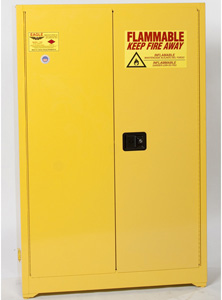



Find all of your laboratory and workplace safety supplies at Safety Emporium!
 Coma |
 Glossary Index |
 Concentration |
| MSDS Topics |
Free Sites | FAQ's | Regulations | Glossary | Software | Suppliers |
| Books | Forum | Poll | Fun stuff | Quiz | Store | |
| Understand your MSDS with the MS-Demystifier | Search ALL our MSDS info | |||||

Store and dispense flammable liquids safely with flammable liquid safety cans from Safety Emporium.
A combustible material is a solid or liquid than can be easily ignited and burned. OSHA, DOT, and other federal regulations, apply specific technical definitions to this term.
Combustible solids are those capable of igniting and burning. Wood and paper are examples of such materials.
Appendix B of the 2012 revision of 29 CFR 1910.1200, the OHSA Hazard Communication Standard (HCS 2012) defines ready combustible solids as "powdered, granular, or pasty chemicals which are dangerous if they can be easily ignited by brief contact with an ignition source, such as a burning match, and if the flame spreads rapidly."
Combustible liquids are defined by the National Fire Protection Association code NFPA 30 - Flammable and Combustible Liquids Code as "Any liquid that has a closed-cup flash point at or above 100 deg. F (37.8 deg. C), as determined by the test procedures and apparatus set forth in Section 4.4. Combustible liquids are classified according to Section 4.3." You can view (but not copy, save, or distribute) NFPA 30 on the NFPA web site if you want more details on the classes of combustible liquids.
Spontaneously combustible materials can undergo combustion and burn without the addition of heat or flame; arguably, the term "spontaneously flammable" is more appropriate. See the flammable solids entry for more info.
The US Department of Transportation defines the term readily combustible solids at 49 CFR 173.125 (Subpart D) as materials that:
These are closely related to the third broad class of materials listed under flammable solids.
Prior to 2012, the U.S. Occupational Safety and Health Administration (OSHA) Standard 29 CFR 1910.106 (then titled "Flammable and Combustible Liquids" but now titled simply "Flammable Liquids" ) defined a combustible liquid as "any liquid having a flash point at or above 100 deg. F (37.8 deg. C), but below 200 deg. F (93.3 deg. C), except any mixture having components with flashpoints of 200 deg. F (93.3 deg. C), or higher, the total volume of which make up 99 percent or more of the total volume of the mixture." This definition has been dropped from the current version of 29 CFR 1910.106 which now addresses such materials as flammable in order to bring the standard into compliance with the Globally Harmonized System.
The previous version of 29 CFR 1910.106 is available for historical reference courtesy of the Internet Wayback Machine.
The term combustible can appear in multiple places on a single Safety Data Sheet. For example, it could be mentioned as a physical hazard in Section 2 (Hazard(s) identifications) or in Section 5 (fire-fighting measures).
Proper storage and use of combustible materials is absolutely critical in maintaining a safe work place. Avoid placing or using combustible materials near sources of heat or flame (direct sunlight, furnaces, pilot lights etc.). Use caution when disposing of combustible materials such as linseed oil-soaked rags (which can spontaneously combust). When dispensing combustible or flammable liquids, keep in mind that static electricity poses a very real threat; obey all standard bonding and grounding practices.
Two other tools that can be part of your flammable and combustible liquids safety plan are the use of safety cans and flammable storage cabinets. Safety cans have flash arrestors and gasketed lids to prevent solvent vapors from flashing back to the liquid if ignited. Flammable storage cabinets have insulating double walls and automatically closing doors so that stored solvents will not readily ignite in the event of a fire.
Also note that many common dusts such as flours, and grains can readily combust or even explode. See our dust entry for additional information.

Store your solvents safely with flammable storage safety cabinets from Safety Emporium.
See also: decomposition, flammable, flammable solid, flash point, temperature units.
Additional definitions from Google and OneLook.
Entry last updated: Monday, July 4, 2022. This page is copyright 2000-2025 by ILPI. Unauthorized duplication or posting on other web sites is expressly prohibited. Send suggestions, comments, and new entry desires (include the URL if applicable) to us by email.
Disclaimer: The information contained herein is believed to be true and accurate, however ILPI makes no guarantees concerning the veracity of any statement. Use of any information on this page is at the reader's own risk. ILPI strongly encourages the reader to consult the appropriate local, state and federal agencies concerning the matters discussed herein.